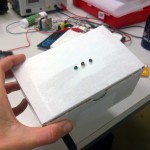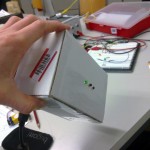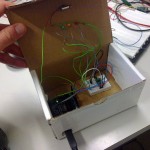24. November 2011
Dreht man die Schachtel in der richtigen Reihenfolge, fängt sie an zu vibrieren. Zudem zeigen LED an ob man eine richtige Seite erwischt hat. Falls man sie falsch herumdreht, erlischen die LED und man muss neu Anfangen. Als Übung wurde von Arduino Daten (Accelerometer) via Processing geschickt und dann wieder zurück (LED) geschickt.
import processing.serial.*;
Serial myPort;
boolean led1, led2, led3;
int xVal, yVal, zVal;
int xPos = 0;
float zRot, yRot;
boolean q1, q2, q3, q4;
void setup() {
background(0);
size(500, 500, P3D);
println(Serial.list());
myPort = new Serial(this, Serial.list()[1], 9600);
}
void draw() {
background(0);
translate(width/2, height/2);
rotateX(radians(map(xVal, -64, 64, 0, 180)));
rotateY(radians(map(yVal, -64, 64, 0, 180)));
fill(255);
box(80, 120, 90);
float triggerPositive = 0.8;
float triggerNegative = 0.2;
float xValCorrected = float(xVal)/64;
float yValCorrected = float(yVal)/64;
float zValCorrected = float(zVal)/64;
println(xValCorrected +"," +yValCorrected +"," +zValCorrected);
//seitenabfrage via accelerometer
if (xValCorrected<triggerNegative && yValCorrected<triggerNegative && zValCorrected>triggerPositive) {
println("seite 1 ist oben");
}
if (xValCorrected<triggerNegative && yValCorrected>triggerPositive && zValCorrected<triggerNegative) {
println("seite 2 ist oben");
led2=true;
if (!led1) {
led1 = false;
led2 = false;
led3 = false;
}
}
if (xValCorrected<triggerNegative && yValCorrected<(-triggerPositive) && zValCorrected<triggerNegative) {
println("seite 3 ist oben");
led1 = false;
led2 = false;
led3 = false;
}
if (xValCorrected<(-triggerPositive) && yValCorrected<triggerNegative && zValCorrected<triggerNegative) {
println("seite 4 ist oben");
if (!led1 || !led2) {
led1 = false;
led2 = false;
led3 = false;
}
else
led3=true;
}
if (xValCorrected>triggerPositive && yValCorrected<triggerNegative && zValCorrected<triggerNegative) {
println("seite 5 ist oben");
led1 = true;
}
if (xValCorrected<triggerNegative && yValCorrected<triggerNegative && zValCorrected<(-triggerPositive)) {
println("seite 6 ist oben");
led1 = false;
led2 = false;
led3 = false;
}
//abfragen, ob die Reihenfolge stimmt
if (led1) {
myPort.write(str(255) +"," +str(0) +"," +str(0) +"," +str(0) +"\r"); //send data to arduino
//println("led 1 Blink!");
if (led2) {
myPort.write(str(255) +"," +str(255) +"," +str(0) +"," +str(0) +"\r"); //send data to arduino
//println("led 2 Blink!");
if (led3) {
//println("led 3 Blink!");
//einfach etwas als Finales machen
myPort.write(str(255) +"," +str(255) +"," +str(255) +"," +str(255) +"\r"); //send data to arduino
delay(500);
myPort.write(str(255) +"," +str(0) +"," +str(0) +"," +str(255) +"\r"); //send data to arduino
delay(500);
myPort.write(str(255) +"," +str(255) +"," +str(0) +"," +str(255) +"\r"); //send data to arduino
delay(500);
myPort.write(str(255) +"," +str(255) +"," +str(255) +"," +str(255) +"\r"); //send data to arduino
delay(500);
myPort.write(str(0) +"," +str(0) +"," +str(0) +"," +str(255) +"\r"); //send data to arduino
delay(500);
myPort.write(str(255) +"," +str(255) +"," +str(255) +"," +str(0) +"\r"); //send data to arduino
delay(100);
myPort.write(str(255) +"," +str(255) +"," +str(255) +"," +str(255) +"\r"); //send data to arduino
delay(100);
myPort.write(str(0) +"," +str(0) +"," +str(0) +"," +str(0) +"\r"); //send data to arduino
delay(100);
myPort.write(str(255) +"," +str(255) +"," +str(255) +"," +str(255) +"\r"); //send data to arduino
delay(100);
myPort.write(str(0) +"," +str(0) +"," +str(0) +"," +str(0) +"\r"); //send data to arduino
delay(100);
myPort.write(str(255) +"," +str(255) +"," +str(255) +"," +str(255) +"\r"); //send data to arduino
delay(100);
myPort.write(str(0) +"," +str(0) +"," +str(0) +"," +str(0) +"\r"); //send data to arduino
delay(100);
myPort.write(str(255) +"," +str(255) +"," +str(255) +"," +str(255) +"\r"); //send data to arduino
delay(100);
myPort.write(str(0) +"," +str(0) +"," +str(0) +"," +str(0) +"\r"); //send data to arduino
led1 = false;
led2 = false;
led3 = false;
println("win!");
}
}
}
else {
myPort.write(str(0) +"," +str(0) +"," +str(0)+"\r"); //send data to arduino
}
}
void serialEvent(Serial myPort) {
if (myPort.available()>0) {
String completeString = myPort.readStringUntil(10);
if (completeString !=null) {
trim(completeString);
String seperateValues[] = split(completeString, "\t");
xVal = int(seperateValues[0]);
yVal = int(seperateValues[1]);
zVal = int(seperateValues[2]);
}
}
}
ARDUINO CODE:
#include <Wire.h> //Include the Wire library
#include <MMA_7455.h> //Include the MMA_7455 library
#define BUFFER_SIZE 20 // actual size of the buffer for integer values: (numberOfValsToRead*6)+(numberOfValsToRead-1)
char incommingBuffer[BUFFER_SIZE]; // buffer to store incomming values
char incomming; // primary buffer to store single incommning bytes
int incommingCounter = 0; // counter for counting the positions inside the buffer
int firstValue, secondValue, thirdValue, fourthValue; // fourthValue, fifthValue, ... // add more if needed
MMA_7455 mySensor = MMA_7455(); //Make an instance of MMA_7455
char xVal, yVal, zVal; //Variables for the values from the sensor
char prevxVal=0, prevyVal=0, prevzVal=0;
float smoothPrev = 0.8;
float smoothNew = 0.2;
void setup()
{
Serial.begin(9600);
// Set the sensitivity you want to use
// 2 = 2g, 4 = 4g, 8 = 8g
mySensor.initSensitivity(2);
// Calibrate the Offset, that values corespond in
// flat position to: xVal = -30, yVal = -20, zVal = +20
// !!!Activate this after having the first values read out!!!
mySensor.calibrateOffset(20, 35, 9);
pinMode(9, OUTPUT); //led
pinMode(10, OUTPUT); //led
pinMode(11, OUTPUT); //led
pinMode(3, OUTPUT); //vibrator
}
void loop()
{
xVal = mySensor.readAxis('x'); //Read out the 'x' Axis
yVal = mySensor.readAxis('y'); //Read out the 'y' Axis
zVal = mySensor.readAxis('z'); //Read out the 'z' Axis
xVal = (smoothPrev * prevxVal) + (smoothNew * xVal);
yVal = (smoothPrev * prevyVal) + (smoothNew * yVal);
zVal = (smoothPrev * prevzVal) + (smoothNew * zVal);
Serial.print(xVal, DEC);
Serial.print("\t");
Serial.print(yVal, DEC);
Serial.print("\t");
Serial.print(zVal, DEC);
Serial.print("\t");
Serial.println();
prevxVal = xVal;
prevyVal = yVal;
prevzVal = zVal;
readSerial(); // read the values available at the serial port
analogWrite(9,firstValue);
analogWrite(10,secondValue);
analogWrite(11,thirdValue);
analogWrite(3,fourthValue);
}
void readSerial()
{
while(Serial.available())
{
incomming = Serial.read(); // read single incommning bytes
if(incomming != '\r') //if no carriage return is received proceed in reading the serial port (untill 'println')
{
incommingBuffer[incommingCounter++] = incomming; // go on the next position in the buffer
}
else //read until a carriage ('\r') is received
{
incommingBuffer[incommingCounter] = '\0'; // set the last byte to NULL to sign it for the string operators
char *a = strtok(incommingBuffer, ",.;"); // split the string after delimiters into tokens
char *b = strtok(NULL, ",.;"); // ...
char *c = strtok(NULL, ",.;"); // ...
char *d = strtok(NULL, ",.;"); // add another line if needed
firstValue = atoi(a); // convert the strings into integers
secondValue = atoi(b); // ...
thirdValue = atoi(c); // ...
fourthValue = atoi(d); // add another line if needed
incommingCounter = 0; // reset the counter
memset(incommingBuffer, 0, BUFFER_SIZE); //overwrite the incommingBuffer
}
}
}


